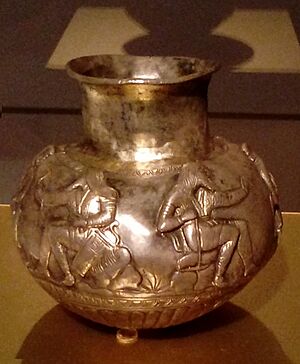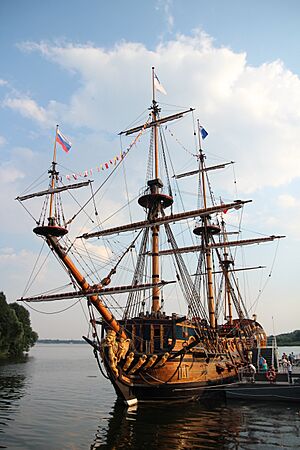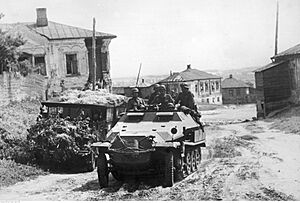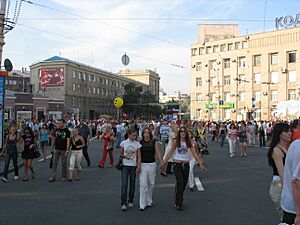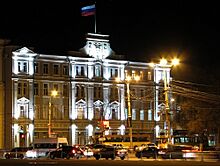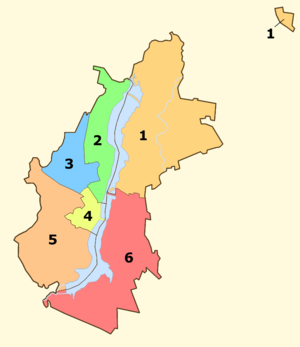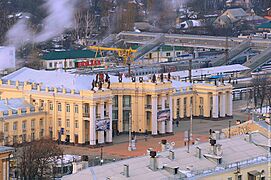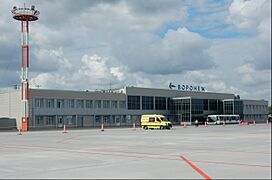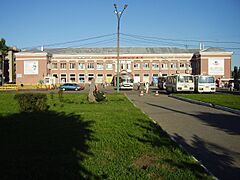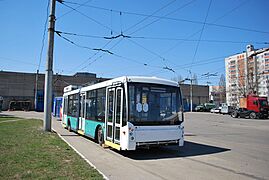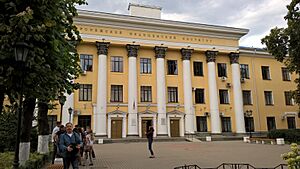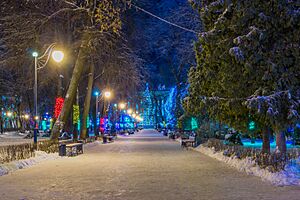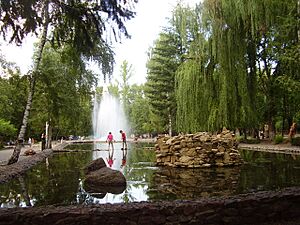Voronezh facts for kids
Quick facts for kids Voronezh (English)Воронеж (Russian) |
|
|---|---|
| - City - | |
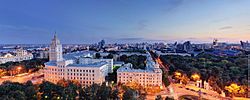 Main building of the South Eastern Railway Administration |
|
|
|
|
| City Day | Third Saturday of September |
| Administrative status | |
| Country | Russia |
| Federal subject | Voronezh Oblast |
| Administratively subordinated to | Voronezh Urban Okrug |
| Municipal status | |
| Urban okrug | Voronezh Urban Okrug |
| Administrative center of | Voronezh Urban Okrug |
| Mayor | Vadim Kstenin |
| Representative body | City Duma |
| Statistics | |
| Area | 601 km2 (232 sq mi) |
| Population (October 1, 2021 est.) | 1,057,681 inhabitants |
| Density | 1,760/km2 (4,558/sq mi) |
| Time zone | MSK (UTC+04:00) |
| Founded | 1585 or much earlier |
| City status since | 1585 |
| Postal code(s) | 394000–394095 |
| Dialing code(s) | +7 473 |
| Official website: http://www.voronezh-city.ru/ | |
Voronezh is a large city in southwestern Russia. It is the main city of Voronezh Oblast. The city is built along the Voronezh River, which flows into the Don River about 12 kilometers away.
Voronezh is an important stop on the Southeastern Railway. This railway connects western Russia to places like the Ural mountains, Siberia, the Caucasus, and Ukraine. The M4 highway also passes through Voronezh, linking Moscow to southern cities like Rostov-on-Don and Novorossiysk.
The city has grown a lot recently. In 2021, its population reached over 1 million people. This makes it the 14th-most populated city in Russia.
Contents
History of Voronezh
How Voronezh Started
The name "Voronezh" was first written down in 1177. At that time, a prince named Yaropolk fled "to Voronozh." This suggests Voronezh was a known area, likely including the Voronezh River and several small towns.
Archaeologists have found ancient Slavic towns from the 8th to 11th centuries near the modern city. These old settlements stretched for about 42 kilometers.
For many years, people thought the name "Voronezh" came from a person's name, Voroneg. However, many researchers now believe the name comes from the Slavic word voron-, meaning "black" or "dark." This might refer to the dark forests (oak forests) that once covered the area.
A fun, but not scientific, story says the name comes from combining the Russian words for raven (voron) and hedgehog (yezh).
In the 16th century, Russia took control of the area. The city of Voronezh was officially founded in 1585 by Feodor I. It was built as a fort to protect trade routes from attacks by the Nogai Horde and Crimean Tatars. The city was named after the river.
From the 1600s to the 1800s
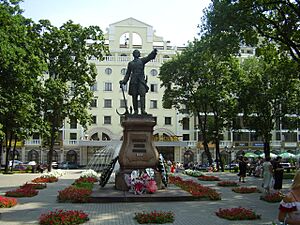
In the 1600s, Voronezh grew into a large town. Peter the Great built a special dockyard here in the late 1600s. This is where the first Russian navy, the Azov Flotilla, was built. It included Russia's first large warship, the Goto Predestinatsia.
Because of this dockyard, Voronezh became the biggest city in Southern Russia for a short time. It was also an important economic center. In 1711, it became the capital of the Azov Governorate, which later became the Voronezh Governorate.
By the 1800s, Voronezh was a busy center for manufacturing. Factories made things like soap, leather, and butter. The city also traded in bread, cattle, and animal fats. A railway line connected Voronezh to Moscow in 1868 and to Rostov-on-Don in 1871.
Voronezh in the 20th Century
World War II
During World War II, Voronezh saw very heavy fighting. German and Hungarian forces attacked the city in June 1942. They wanted to use it as a base for their attack on Stalingrad.
Voronezh was important for making weapons. In 1941, the city's factories built Katyusha rocket launchers. More than 300 of these were used in a counterattack near Moscow.
The fighting in Voronezh was very intense. By July 1942, the battle line settled along the Voronezh River. The city was almost completely destroyed, with 92% of its buildings ruined. On January 25, 1943, Soviet forces finally took back the city after ten days of combat.
After the War
After the war, Voronezh was quickly rebuilt. By 1950, most of its buildings and historical sites were repaired. New factories were also built, making tires, machine tools, and other heavy machinery.
In 1968, the Voronezh Aviation factory began making the Tupolev Tu-144 supersonic plane. This was a very fast passenger jet. In 1977, the factory also built the first Soviet wide-body plane, the Ilyushin Il-86.
In 1989, there were reports of a possible UFO landing in a city park. Some children claimed to have seen aliens. However, scientists and reporters later said that parts of the story might have been made up.
Voronezh in the 21st Century
In 2011, Voronezh celebrated its 425th anniversary. This big celebration helped bring in money for the city's development.
In 2012, Voronezh became the 15th city in Russia to have over one million people living in it.
Today, Voronezh is a key center for business, industry, culture, and science in its region. Every winter, the main city square is decorated with themes from classic stories. For example, in 2020, it was decorated like Pyotr Ilyich Tchaikovsky's The Nutcracker. In 2021, it was inspired by Hans Christian Andersen's fairy tale The Snow Queen.
In June 2023, during a brief period of unrest, some military facilities in the city were reported to be under the control of a private military group.
City Government and Divisions
Voronezh is the main administrative center of its region, called an oblast. It is organized as a "Voronezh Urban Okrug." This means it's a special administrative area that has the same status as a district.
The city is divided into six administrative districts:
- Zheleznodorozhny
- Tsentralny
- Kominternovsky
- Leninsky
- Sovetsky
- Levoberezhny
Population and People
| Historical population | ||
|---|---|---|
| Year | Pop. | ±% |
| 1897 | 80,599 | — |
| 1926 | 118,191 | +46.6% |
| 1939 | 326,932 | +176.6% |
| 1959 | 447,164 | +36.8% |
| 1970 | 660,182 | +47.6% |
| 1979 | 782,950 | +18.6% |
| 1989 | 886,844 | +13.3% |
| 2002 | 848,752 | −4.3% |
| 2010 | 889,680 | +4.8% |
| 2021 | 1,057,681 | +18.9% |
| Source: Census data | ||
According to the 2021 Census, most people in Voronezh are Russians. Here's a look at the different groups:
| Ethnicity | Population | Percentage |
|---|---|---|
| Russians | 918,247 | 95.6% |
| Ukrainians | 4,806 | 0.5% |
| Armenians | 4,416 | 0.5% |
| Tajiks | 1,946 | 0.2% |
| Uzbeks | 1,707 | 0.2% |
| Azerbaijanis | 1,679 | 0.2% |
| Turkmens | 1,383 | 0.1% |
| Others | 26,173 | 2.7% |
Economy and Industry
In the 20th century, Voronezh's main industries were:
- Mechanical engineering: designing and building machines.
- Metalworking: shaping and working with metals.
- Electronics industry: making electronic devices.
- Food industry: processing and preparing food.
Some important companies in Voronezh include:
- Voronezh Aircraft Production Association: This factory built the Tupolev Tu-144 supersonic jet.
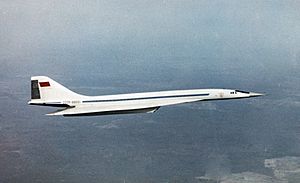
- Voronezhselmash: Makes equipment for farming.
- Sozvezdie: A company that developed the world's first mobile phone system in 1958.
- Verofarm: A pharmaceutical company (makes medicines).
- Voronezh Mechanical Plant: Produces engines for rockets and aircraft, plus oil and gas equipment.
- Mining Machinery Holding - RUDGORMASH: Makes equipment for drilling and mining.
- KBKhA Chemical Automatics Design Bureau: Designs and builds rocket engines.
- Pirelli Voronezh: A tire manufacturing plant.
The city is also developing "industrial parks" like "Maslowski." These parks offer special benefits to new businesses to encourage them to set up factories there. For example, Siemens has a transformer factory in Maslowski. In 2011, Nokia Siemens Networks opened a global network operation center in Voronezh, which was the first in Russia.
Construction
In 2014, over 926,000 square meters of new homes were built in Voronezh.
City Clusters
Voronezh has special "clusters" for different industries. These clusters get support from the government, like tax benefits. Some of these clusters include:
- Oil and Gas Equipment
- Radio-electronic (electronics)
- Furniture
- IT (Information Technology)
- Aircraft
- Electromechanics
- Transport and logistics
- Building materials and technologies
Geography and Climate
City Layout
Voronezh started as a military fort in 1585. The original fortress was a rough four-sided shape, about 238 meters around. It was a typical military settlement, designed to protect soldiers.
Outside the main fort, there were settlements for different groups of military men, like archers and Cossacks. These settlements formed a ring around the fortress. The churches were also placed to show this circular layout of the early city.
Climate
Voronezh has a humid continental climate. This means it has long, cold winters and short, warm summers.
| Climate data for Voronezh (1991–2020, extremes 1918–present) | |||||||||||||
|---|---|---|---|---|---|---|---|---|---|---|---|---|---|
| Month | Jan | Feb | Mar | Apr | May | Jun | Jul | Aug | Sep | Oct | Nov | Dec | Year |
| Record high °C (°F) | 8.3 (46.9) |
11.0 (51.8) |
22.7 (72.9) |
29.2 (84.6) |
35.7 (96.3) |
38.9 (102.0) |
40.1 (104.2) |
40.5 (104.9) |
34.4 (93.9) |
26.5 (79.7) |
18.2 (64.8) |
12.4 (54.3) |
40.5 (104.9) |
| Mean daily maximum °C (°F) | −3.4 (25.9) |
−2.6 (27.3) |
3.6 (38.5) |
14.4 (57.9) |
21.7 (71.1) |
25.0 (77.0) |
27.2 (81.0) |
26.5 (79.7) |
19.7 (67.5) |
11.5 (52.7) |
3.0 (37.4) |
−1.9 (28.6) |
12.1 (53.8) |
| Daily mean °C (°F) | −6.0 (21.2) |
−5.7 (21.7) |
−0.3 (31.5) |
8.7 (47.7) |
15.5 (59.9) |
19.1 (66.4) |
21.1 (70.0) |
19.9 (67.8) |
14.0 (57.2) |
7.4 (45.3) |
0.4 (32.7) |
−4.3 (24.3) |
7.5 (45.5) |
| Mean daily minimum °C (°F) | −8.5 (16.7) |
−8.5 (16.7) |
−3.5 (25.7) |
3.9 (39.0) |
9.8 (49.6) |
13.7 (56.7) |
15.6 (60.1) |
14.2 (57.6) |
9.2 (48.6) |
4.0 (39.2) |
−1.9 (28.6) |
−6.6 (20.1) |
3.5 (38.3) |
| Record low °C (°F) | −36.5 (−33.7) |
−36.2 (−33.2) |
−32.0 (−25.6) |
−16.8 (1.8) |
−3.3 (26.1) |
−1.6 (29.1) |
5.0 (41.0) |
0.4 (32.7) |
−5.2 (22.6) |
−15.2 (4.6) |
−25.1 (−13.2) |
−33.4 (−28.1) |
−36.5 (−33.7) |
| Average precipitation mm (inches) | 42 (1.7) |
39 (1.5) |
38 (1.5) |
41 (1.6) |
48 (1.9) |
61 (2.4) |
58 (2.3) |
52 (2.0) |
51 (2.0) |
51 (2.0) |
43 (1.7) |
48 (1.9) |
572 (22.5) |
| Average extreme snow depth cm (inches) | 16 (6.3) |
22 (8.7) |
16 (6.3) |
1 (0.4) |
0 (0) |
0 (0) |
0 (0) |
0 (0) |
0 (0) |
0 (0) |
2 (0.8) |
9 (3.5) |
22 (8.7) |
| Average rainy days | 8 | 6 | 8 | 12 | 13 | 15 | 13 | 10 | 13 | 14 | 13 | 9 | 134 |
| Average snowy days | 21 | 20 | 14 | 3 | 0.2 | 0 | 0 | 0 | 0.1 | 3 | 12 | 20 | 93 |
| Average relative humidity (%) | 84 | 82 | 77 | 66 | 61 | 67 | 68 | 67 | 73 | 79 | 85 | 85 | 75 |
| Mean monthly sunshine hours | 62 | 86 | 125 | 184 | 268 | 284 | 286 | 254 | 185 | 111 | 45 | 38 | 1,928 |
| Source 1: Pogoda.ru.net | |||||||||||||
| Source 2: NOAA (sun, 1961–1990) | |||||||||||||
Transportation in Voronezh
Air Travel
Voronezh has an international airport called Voronezh International Airport. It is located north of the city. The city also has the Pridacha Airport, which is part of a big aircraft manufacturing factory called VASO. This is where the Tupolev Tu-144 was built. There is also a military air force base called Voronezh Malshevo in the southwest of the city.
Train Travel
Voronezh has had a railway connection to Moscow since 1868. Train services are part of the South Eastern Railway. You can take a train from Voronezh to many cities, including Moscow, Kyiv, and Sochi. The main train station is called Voronezh-1 railway station.
Bus Travel
There are three bus stations in Voronezh. They connect the city to other places like Moscow, Belgorod, and Rostov-on-Don.
Education and Culture
Voronezh is a big center for higher education in central Russia. It has many universities and institutes, including:
- Voronezh State University
- Voronezh State Technical University
- Voronezh State Medical University
- Voronezh State Agricultural University
- Military Educational and Scientific Center of the Air Force
The city also has seven theaters, twelve museums, many movie theaters, a concert hall, and a circus. There are also 2000 schools in the city.
Theaters in Voronezh
- Voronezh Chamber Theatre
- Koltsov Academic Drama Theater
- Voronezh State Opera and Ballet Theatre
- Shut Puppet Theater
Festivals
The Platonov International Arts Festival is a well-known event held in Voronezh.
Sports
| Club | Sport | Founded | Current League | League Rank |
Stadium |
|---|---|---|---|---|---|
| Fakel Voronezh | Football | 1947 | Russian Premier League | 1st | Tsentralnyi Profsoyuz Stadion |
| Energy Voronezh | Football | 1989 | Women's Premier League | 1st | Rudgormash Stadium |
| Buran Voronezh | Ice Hockey | 1977 | Higher Hockey League | 2nd | Yubileyny Sports Palace |
| VC Voronezh | Volleyball | 2006 | Women's Higher Volleyball League A | 2nd | Kristall Sports Complex |
Religion
The main religion in Voronezh is Orthodox Christianity.
There is also an Orthodox Jewish community in Voronezh, with a synagogue.
In 1682, the Voronezh diocese (a church district) was created. Its first leader was Bishop Mitrofan. He started building a new Annunciation Cathedral. In 1832, Mitrofan was recognized as a saint by the Russian Orthodox Church.
In the 1990s, many Orthodox churches were given back to the diocese and restored. In 2009, a new Annunciation Cathedral was built where the old one used to be. A monument to Saint Mitrofan was placed next to it.
Cemeteries
There are ten cemeteries in Voronezh:
- Levoberezhnoye Cemetery
- Lesnoye Cemetery
- Jewish Cemetery
- Nikolskoye Cemetery
- Pravoberezhnoye Cemetery
- Budyonnovskoe Cemetery
- Yugo-Zapadnoye Cemetery
- Podgorenskоye Cemetery
- Kominternovskoe Cemetery
Ternovoye Cemetery is a historical site and is not open to the public.
Notable People
Sister Cities
Voronezh has sister cities around the world:
| Date | Sister City | |
|---|---|---|
| 1989 | Wesermarsch, Lower Saxony, Germany | |
| 1991 | Charlotte, North Carolina, United States | |
| 1992 | Chongqing, China | |
| 1995 | Sliven, Bulgaria | |
| 1996 | León, Castile and León, Spain |
See also
 In Spanish: Vorónezh para niños
In Spanish: Vorónezh para niños



